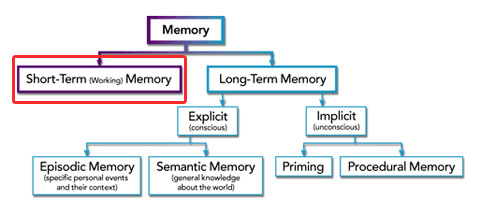 Our short-term memory is closely related to what is referred to as ‘working memory’ and acts like the brain’s receptionist. Short-term memory is one of two main memory types and is responsible for temporarily storing information and then determining if the information should be transferred to long-term memory or simply dismissed.
Our short-term memory is closely related to what is referred to as ‘working memory’ and acts like the brain’s receptionist. Short-term memory is one of two main memory types and is responsible for temporarily storing information and then determining if the information should be transferred to long-term memory or simply dismissed.
This process, although it might sound somewhat complicated, is completed by your short-term memory in under a minute. Right now, for example, your short-term memory is helping you by storing information you gathered from the beginning of this sentence so that you can make complete sense of it by the time you reach the end. Scientists have, more recently, been diving deeper into understanding the brain’s short-term memory functions and have identified “working” memory which is a similar (but separate) type of memory.
Short-Term Memory vs. Working Memory
Although short-term memory and working memory are often used interchangeably, working memory is actually a newer concept that emphasizes how the brain manipulates information it receives (storing it, using it, etc.) and is often thought of as the brain’s “scratch pad” that keeps information – a name, a phone number, or whatever else – available just long enough to be used. Short-term memory, on the other hand, is a more passive concept.
Short-Term Memory & Age
The length of time our short-term memory is able to store information decreases as we grow older. We are more likely to experience difficulty keeping up with certain tasks as a result of aging and other clinical conditions, like remembering which button in a department store phone menu to press.
We are also more likely to forget details of recent events because the decreasing length of time means our brains have less time to successfully move new information to our long-term memory. Although cognitive decline and memory lapses are a normal part of the aging process you can work towards a slow down of the process by keeping your memory active and maintaining a brain-healthy lifestyle.







 English
English
 Français
Français


